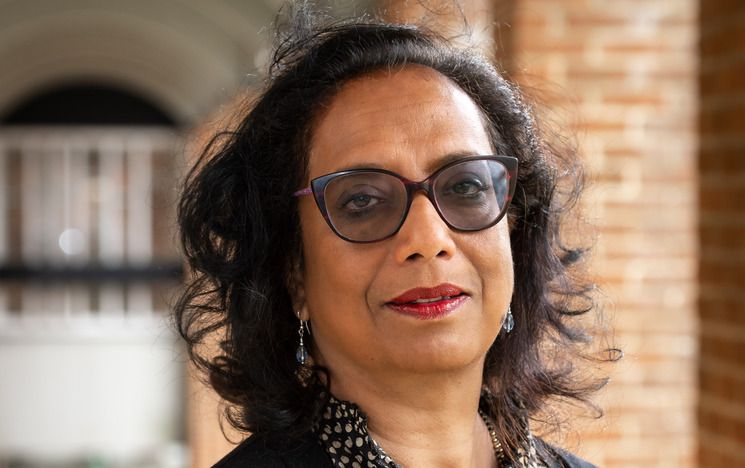Building bridges
Historical colonial records on natural history have powerful political charge and policy relevance for the 21st Century global world.

The past as an ongoing resource for present social justice claims
Over the last twenty years, Professor Vinita Damodaran has played a crucial role in the development of histories of the environment. She has studied both material changes in the environment and local interactions with it. Her work demonstrates how the past provides an ongoing resource and context for present social justice claims. Her work on archival collections has inspired lasting impacts across two continents and has built bridges between international scholars, activists, and wider diverse public audiences around issues of social justice, historical resource use, and climate change.
The destruction of the Saranda Forest in India attracted press attention when Adivasi activist Gladson Dungdung was barred from leaving India to attend a Sussex workshop on the matter in 2016. The confiscation of his passport by the Indian government was raised in the Upper House of India Parliament. Subsequently he was able to attend a 2017 conference at the Indian Museum Kolkata on ‘Forests, Sacred Groves and the Environmental Heritage of India’ which drew attention to the natural heritage of India’s indigenous communities and highlighted the destruction through mining of key natural heritage sites in tribal areas. His participation created deeper engagement with marginalised indigenous students on the issue of mining destruction and tribal landscapes.
Rinu Kumari, a tribal research scholar from Kolhan University, wrote about how Professor Damodaran’s research has changed perceptions: ‘tribal people are very scared of the people from outside, after meeting you I felt some people truly think about us in the right way; you have given a new direction to my life.’
Building bridges across continents, communities, and disciplines.
From the British Library, Royal Botanic Gardens at Kew, to the Wellcome Trust, and the Met Office in the UK, to the National Museum of Natural History in Delhi and the Botanical Survey of India, Professor Damodaran has enabled collaborations across the globe, and has connected academics, archivists, curators, scientists, and communities, reaching audiences worldwide, sometimes for the very first time. Professor Damodaran led the ‘Botanical and Meteorological History of the Indian Ocean’ network project that drew together over 90 stakeholders across two continents. The project transcribed, collated, and digitised, a wealth of botanical and environmental knowledge collected between the 17th and the 19th centuries, and made these resources more accessible in the Global South.
Professor Damodaran’s research has helped improve the data available to best predict climate variability. Her work brought the Humanities into the heart of the Met Office. By recovering and digitising previously neglected historical climate evidence, Professor Damodaran’s research has extended the use of data available to predict climate change and has brought a wider socio-historical and economic perspective which deepens and enriches the extent of the Met Office’s work. She was part of a global team that drew up the World Meteorological Organisation’s Indian Ocean Data Rescue Initiative implementation plan in 2014. Eleven Indian Ocean Rim countries signed up to it, committing to enhance the quality and quantity of historical weather data to improve their policy and decision making. For example, Mauritius, via their Meteorological Society, is now scanning the 188 volumes of ship logbooks of vessels that were at harbour in Port Louis from the 1850s to the First World War.
Repatriating knowledge and restoring key botanical figures
Professor Damodaran’s ground-breaking work on E. K. Janaki Ammal, the first female employee of the Royal Horticultural Society and Director of the Botanical Survey of India, restored a previously hidden figure to the history of science, one who attempted to challenge Kew’s imperialist approach to plant classification.
E. K. Janaki Ammal, was practically unknown in India, as well as in the UK, until Damodaran curated the first exhibition of Ammal’s life, letters and works. The exhibition was opened by Sri Ajay Narayan Jha, who was then the Secretary of the Ministry of Climate Change, Environment and Forests in the Indian government, and toured Kolkata and Delhi from 2016 to 2018. It is currently on permanent exhibition at the Botanic Garden of India in Uttar Pradesh. It run alongside ‘Hooker, Botanical Trailblazer’, an exhibition about Kew's most renowned Director and all-round scientific polymath Joseph Hooker. It combined Kew materials with collections from the Botanical Survey of India and other Indian institutions facilitating significant additional global reach in the bicentenary year of Hooker’s birth.
New educational initiatives and innovative curriculum
Professor Damodaran’s research has inspired schools and educational outreach programmes in India. A pilot project with two local schools in Kolkata – Dum Dum Motijheel Girls’ High School and Kishore Bharati High School – gave children the opportunity to engage with the natural history collecting practices of the British Empire and the co-construction of botanical knowledge by local communities, including Adivasis in India. They also learned about the conservation of the endangered flora of South Asia and about the environmental and plant knowledge of India’s indigenous communities.
For the first time, Botanical Survey of India opened up their collections to children from underprivileged backgrounds and engaged with them through talks, discussions and essay projects. The programme developed study kits, all in Bengali and English, on topics ranging from medicinal plants to climate change produced in conjunction with scientists and teachers. The sessions improved student understanding of the natural history collection, of the role of botanical knowledge (both colonial and indigenous), and of the importance of India’s botanical heritage and its conservation in terms of India’s endangered flora and fauna. The pilot study shaped ongoing educational work and persuaded it to continue and extend the programme as the ‘Environmental Education Awareness Programme’ (EEAP) in India, an important legacy of Damodaran’s project.